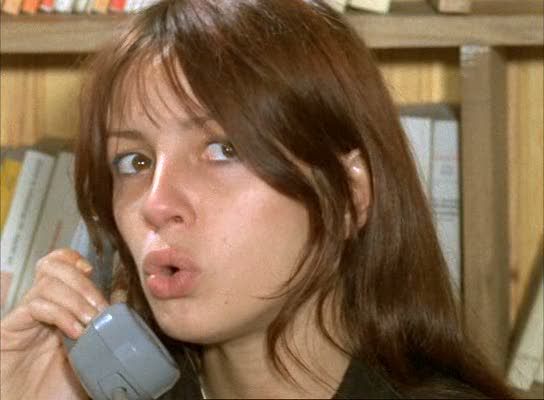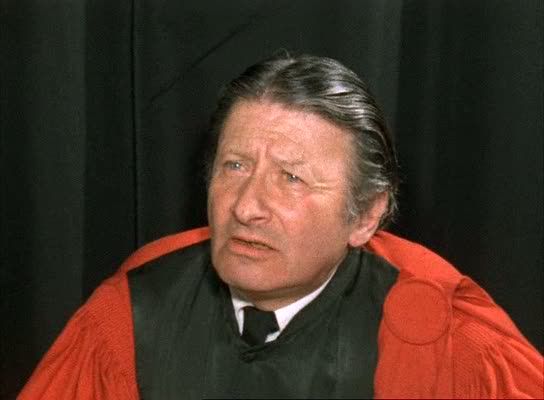
Vladimir and Rosa was in many ways the last true product of the experimental revolutionary filmmaking cooperative the Dziga Vertov Group: the final film produced under the group's banner before Jean-Luc Godard and Jean-Pierre Gorin went on to make the feature Tout va bien and the short Letter To Jane under their own names, before parting ways for good. Taking its title from Vladimir Lenin and Rosa Luxemburg, this film is typical of Godard and Gorin's late 60s/early 70s collaborations. That is to say, it's shrill, antagonistic, messy and often intentionally grating, as dense and complex as it is difficult and polemical. But it is also wickedly funny, aesthetically restless and inventive, and truly committed to considering every angle, every variation, on the ideas and situations it discusses. It is quite possibly the best film to emerge from the Dziga Vertov collective, the film where (prior to Tout va bien at least) the political ideas of Godard and Gorin are most cogently (and entertainingly) presented.
Although most of the DVG films are aesthetically and thematically catholic, broad in their consideration of various elements of capitalist society, Vladimir and Rosa narrows its focus to the trial of the Chicago Eight, the famous group of radical activists (including Abbie Hoffman and Black Panther Bobby Seale) who were tried in connection with the riots and protests at the 1968 Democratic Convention. Predictably, Godard and Gorin play fast and loose with the facts, staging the trial as a symbolic conflict between representatives of various left-wing factions on one side, and the bourgeois establishment on the other. Thus, the eight defendants in the film do not correspond exactly to the real activists; only the extreme pacifist Dave Dellinger (Claude Nedjar) and the Black Panther Bobby X refer to real people. The rest of the eight are filled out with archetypes in order to present a cross-section of radical politics: a hippie commune member (Juliet Berto), a proponent of women's rights (Anne Wiazemsky), a factory worker and "individualist" agitator (Larry Martin), a student revolutionary (Yves Afonso), and others. Against these diverse radicals and Marxist thinkers are arrayed the forces of the pompous, oppressive judge Julius Himmler (Ernest Menzer) — a fascist parody of real Chicago Eight judge Julius Hoffman — and a jury comprised entirely of blank-faced bourgeois housewives and office drones.
The trial in the film plays out very similarly to the one presented in Peter Watkins' contemporaneous Punishment Park, which must have been in production in America at roughly the same time as Godard and Gorin were making their own film in France: tapping into the zeitgeist on both sides of the Atlantic. In Watkins' film, sequences from an obviously unbalanced and unjust trial are juxtaposed with images of the punishment, a torturous race through a desert wasteland pursued by heavily armed police. In Vladimir and Rosa, the trial itself is the sole focus, staged in a minimally designed courtroom with ancillary sequences about the defendants' attempts to hone and understand both what they're fighting for and how they should fight. These segments are further interspersed with meta-commentary from Vladimir Lenin (Godard) and Karl Rosa (Gorin), who debate and discuss how best to represent the story of the Chicago Eight as a film. As with all of the DVG films, Vladimir and Rosa is as much about the process of making the film as it is about the subject itself. Godard and Gorin were not concerned only with the Chicago Eight and the unjust nature of their trial — they were equally concerned with the question of how to tell this story, how to use the cinema as an ideological tool for understanding the meaning of the Chicago Eight trial.
To this end, Godard and Gorin's characters engage in a series of loosely comic skits in which they attempt to come to terms with the limits of cinematic representation. At one point, they stalk back and forth down the center of a tennis court as a pair of white-clad couples try to play around the pacing filmmakers. As they traverse the court, they speak into audio apparatuses that simultaneously amplify and distort their voices, creating disorienting echo effects that make their conversation difficult to follow. And yet this effect is precisely what they're talking about: the difficulty of making themselves understood, the imprecision of language and images in dealing with complex ideological matters. This segment is an acknowledgment that their filmmaking equipment is both a gift and a curse. Just as it amplifies their voices, allowing them to spread their message further and more easily, it also distorts what they have to say, ironically blurring the message even as it is disseminated. Later, the filmmakers show up in disguise as bourgeois oppressors, Godard in a fetishistic cop uniform and Gorin draped in judge's robes, the two of them playacting as authority figures. Playfully perverse as ever, Godard pulls a lengthy nightstick out of his unzipped fly as a demonstration of violent oppression (and its unspoken sexual component) in action.

Scenes like this counter the typical impression of Godard's Dziga Vertov period as joyless or humorless. Indeed, in this film his gnomic sense of humor is especially lively, expressing itself in the form of blunt and pointed satire. Judge Himmler is a nasty but hilarious satirical concoction, living up to his fascist name with his cartoonish screech of a voice and his knee-jerk tendency to deny all of the defense's requests and grant all of the prosecution's. He seems to be on the verge of falling asleep whenever one of the defendants delivers a lengthy polemical speech, he pounds repeatedly for silence with his gavel until the wooden block on his desk goes flying through the air, and he doodles absent-mindedly on the Playboy spreads strewn across his bench. He's an absurd caricature of corrupt authority, an editorial page cartoon who might as well have a label hung around his neck to complete the picture. Godard and Gorin are painting in primary colors here, but it works because their actors are fully engaged in this broad satirical project, especially the fiery Menzer and the always enjoyable Juliet Berto, who even casts knowing glances at the audience from time to time, as though to include them in on the joke. There's a level of self-awareness about it all that rescues the film from its own polemical excesses, like its repeated reliance on Nazi comparisons.
This is, of course, one of the primary goals of the Dziga Vertov Group, to make films that question themselves, that engage with economic and social conditions at every level. Throughout the film, they question the commitment of various groups to radical revolution, asking what separates a hippie commune from the way its members lived outside of the commune, or how a supposedly radical lawyer like William Kuntsler, who defended the real Chicago Eight, can reconcile his radicalism with the comfort of his economic existence, his nice apartment and car. There's a real potential here for Godard and Gorin to come off as sanctimonious, as self-righteous posers placing themselves on a higher intellectual plane than their subjects. But it's obvious that they're not exempting themselves from these inquiries, they're not pretending that they have achieved any kind of revolutionary perfection. Their film is susceptible to the same failures, the same limitations, as any other project that attempts to exist outside of an all-pervasive system. What they're after, more than anything, is a recognition of those limitations, a continual process of investigation and, above all, careful thought.
The film also engages directly with questions of race and gender, particularly in the characters of Bobby X and Anne Wiazemsky. The former, like his real-life counterpart Bobby Seale, is marginalized even at the trial, separated from the other defendants, continually denied his right to defend himself or speak for himself. He is, like Seale, chained to a chair, bound and gagged in court, a gesture of extreme restraint that robs him of his rights. He is, eventually, in the film as in life, excluded from the trial altogether, shuffled off into a separate trial so that the Chicago Eight became the Chicago Seven. The film dramatizes this absence in two ways: first, visually, through the use of an empty red chair that calls attention to Bobby's absence, and second, abstractly, with the use of black frames. Throughout the DVG period, Godard frequently used black leader to convey absence and to separate images from one another, and here his voiceover self-consciously states that these interjections have finally achieved their purpose as a way of indicating the disappearance of a black revolutionary. Bobby is, alone among the film's subjects, held up as exempt from Godard and Gorin's commentary on revolutionary limits: because of his race, he is truly outside bourgeois society in a way that privileged whites like the filmmakers and other actors have to struggle and fight towards.
The film also acknowledges the differences in male and female understandings of oppression and class, and one scene attempts to bridge the inevitable gap by having Wiazemsky and Afonso take turns reading from a treatise written by an African woman. This is a film about trying to understand other ways of viewing the world: just as Godard and Gorin are approaching the experience of American activists through the story of the Chicago Eight/Seven, the film incorporates various attempts at understanding how issues of class, race, sex and violence might be seen differently by different kinds of people. As the climax of the Dziga Vertov Group's ongoing project towards a revolutionary cinema, Vladimir and Rosa is a dense, confounding and strangely engaging work. The witty, dialectical reversals of Godard and Gorin drive the film, dealing intelligently with the various contradictions, oppositions and paradoxes at the heart of capitalist society.

2 comments:
This is an excellent review and probably the most definitive post on the web at this particular point in time (or at least from the ones I've read). As you remember, I wrote a vague review of this and several other DVG films last year, but in comparison, it was basically just an outline and certainly didn't go into the kind of detail as featured here.
One question though: assuming these screenshots are your own, where did you find such a great print?
Out of all the DVG films I saw last year, I'd say this was my second favourite after British Sounds. Pravda and Struggles in Italy were both interesting, but seemed to conform too much to the idea of humourless, polemic essay that many people have when they think of Godard's post-New Wave political period, while Wind from the East was fascinating, but far too deteriorated a version for me to really see what Godard and Gorin had intended (creatively speaking).
Of course, Tout va bien is still my absolute favourite of this period, and a film worthy of discussion alongside any of Godard's work from the mid-to-late 1960's.
Thanks, Linden. I really enjoyed this one, possibly almost as much as the great Tout va bien, and certainly more than the comparatively schematic (but interesting) British Sounds or Struggles In Italy (I still have to see the others).
The screenshots are from a print of the film I downloaded online. Last year there was a DVD box set released in Spain, featuring all the DVG films, but unfortunately no English subtitles. However, most of the films from this box have found their way online, where people have created their own English subtitles for at least some of them. So pristine copies of most of the DVG films are now available, thankfully. It can only be a matter of time before someone puts together a definitive box set of these for the English-language world (maybe Artificial Eye?).
Post a Comment